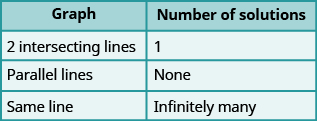| << Chapter < Page | Chapter >> Page > |
Coincident lines have the same slope and same y -intercept.
There will be times when we will want to know how many solutions there will be to a system of linear equations, but we might not actually have to find the solution. It will be helpful to determine this without graphing.
We have seen that two lines in the same plane must either intersect or are parallel. The systems of equations in [link] through [link] all had two intersecting lines. Each system had one solution.
A system with parallel lines, like [link] , has no solution. What happened in [link] ? The equations have coincident lines , and so the system had infinitely many solutions.
We’ll organize these results in [link] below:

Parallel lines have the same slope but different y -intercepts. So, if we write both equations in a system of linear equations in slope–intercept form, we can see how many solutions there will be without graphing! Look at the system we solved in [link] .
The two lines have the same slope but different y -intercepts. They are parallel lines.
[link] shows how to determine the number of solutions of a linear system by looking at the slopes and intercepts.

Let’s take one more look at our equations in [link] that gave us parallel lines.
When both lines were in slope-intercept form we had:
Do you recognize that it is impossible to have a single ordered pair that is a solution to both of those equations?
We call a system of equations like this an inconsistent system . It has no solution.
A system of equations that has at least one solution is called a consistent system .
A consistent system of equations is a system of equations with at least one solution.
An inconsistent system of equations is a system of equations with no solution.
We also categorize the equations in a system of equations by calling the equations independent or dependent . If two equations are independent equations , they each have their own set of solutions. Intersecting lines and parallel lines are independent.
If two equations are dependent, all the solutions of one equation are also solutions of the other equation. When we graph two dependent equations , we get coincident lines.
Two equations are independent if they have different solutions.
Two equations are dependent if all the solutions of one equation are also solutions of the other equation.
Let’s sum this up by looking at the graphs of the three types of systems. See [link] and [link] .


Without graphing, determine the number of solutions and then classify the system of equations:
A system of equations whose graphs are parallel lines has no solution and is inconsistent and independent.

Notification Switch
Would you like to follow the 'Elementary algebra' conversation and receive update notifications?